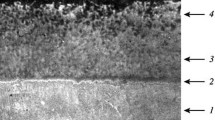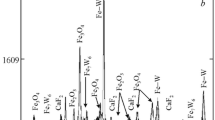Abstract
The tribological properties have been examined for composite materials based on binary titanium-chromium boride and titanium nitride under conditions of dry friction over a wide speed range (1–25 m/sec). The materials have good tribological properties, which exceed by almost an order of magnitude those of known materials. Specifications are formulated for materials promising for high-speed friction units. A necessary condition for viability in high-speed friction units is high strength of the adhesion between the films of oxidation products, and another is low tendency for adhesion with the counterbody.
Similar content being viewed by others
REFERENCES
I. V. Kragel'skii, Friction and Wear in Machines [in Russian], Mashgiz, Moscow (1962).
I. V. Kragel'skii, M. N. Dobychin, and V. S. Kombalov, The Principles of Calculations on Friction and Wear [in Russian], Mashinostroenie, Moscow (1977).
F. P. Bowden and D. Tabor, Solid Friction and Lubrication [Russian translation], Mashinostroenie, Moscow (1968).
G. V. Samsonov and I. M. Vinitskii, Refractory Compounds [in Russian], Metallurgiya, Moscow (1976).
I. M. Fedorchenko and L. I. Pugina, Sintered Antifriction Composite Materials [in Russian], Nauk. Dumka, Kiev (1980).
R. F. Voitovich and E. A. Pugach, “High-temperature oxidation of group IV borides: The oxidation of titanium diboride,” Poroshk. Metall., No. 2, 57–62 (1975).
G. N. Komratov, “Oxidation kinetics of titanium diboride powders,” Poroshk. Metall., Nos. 1–2, 77–81 (1996).
T. M. Evtushok, G. L. Zhunkovskii, L. V. Strashinskaya, et al., “Effects of titanium nitride on the tribotechnical properties of antifriction composites,” in: Refractory Nitrides and Materials Based on Them [in Russian], Institute for Problems of Materials Science, National Academy of Sciences of Ukraine, Kiev (1992), pp. 184–190.
O. A. Pozdnyakov, L. E. Kobzar', A. F. Minak, et al., “Evaluating the performance of bearings made of nontraditional materials for a turbocompressor,” in: Internal Combustion Engines, Issue 5 [in Russian], Kharkov Politekh. Inst., Kharkov (1990), pp. 109–112.
G. L. Zhunkovskii, T. M. Evtushok, P. V. Mazur, et al., “Wear-resistant materials based on borides,” in: Borides and Materials Based on Them [in Russian], Institute for Problems of Materials Science, National Academy of Sciences of Ukraine, Kiev (1994), pp. 147–150.
R. F. Voitovich, The Oxidation of Carbides and Nitrides [in Russian], Nauk. Dumka, Kiev (1981).
Author information
Authors and Affiliations
Additional information
__________
Translated from Poroshkovaya Metallurgiya, Nos. 7–8(444), pp. 58–64, July–August, 2005.
Rights and permissions
About this article
Cite this article
Evtushok, T.M., Grigor'ev, O.N., Kostenko, A.D. et al. Tribological Properties of Composite Materials Based on Refractory Titanium Compounds. Powder Metall Met Ceram 44, 353–357 (2005). https://doi.org/10.1007/s11106-005-0102-6
Received:
Issue Date:
DOI: https://doi.org/10.1007/s11106-005-0102-6




